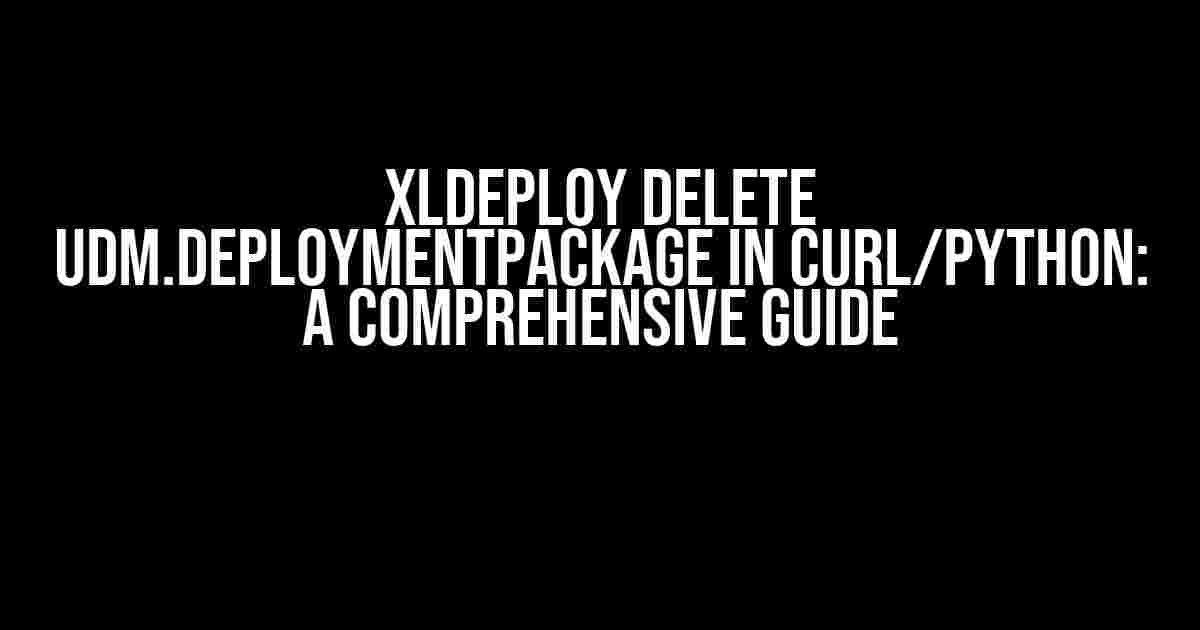Are you tired of manually deleting udm.DeploymentPackages in XLDeploy? Do you want to automate the process using curl or Python? Look no further! In this article, we will provide you with a step-by-step guide on how to delete udm.DeploymentPackages using curl and Python.
Why Delete udm.DeploymentPackages?
Before we dive into the instructions, let’s discuss why deleting udm.DeploymentPackages is necessary. udm.DeploymentPackages are used to store metadata about deployments in XLDeploy. Over time, these packages can accumulate and take up valuable space in your repository. Deleting unnecessary packages can help maintain a clean and organized repository, improve performance, and reduce storage costs.
Prerequisites
Before you begin, make sure you have the following:
- XLDeploy installed and configured
- cURL or Python installed on your machine
- Basic knowledge of curl or Python
Method 1: Deleting udm.DeploymentPackages using Curl
cURL is a command-line tool for transferring data to and from a web server using HTTP, HTTPS, SCP, SFTP, TFTP, and more. We will use curl to send a DELETE request to the XLDeploy API to delete the udm.DeploymentPackage.
Step 1: Authenticate with XLDeploy
To authenticate with XLDeploy, you need to obtain an authentication token. You can do this by sending a POST request to the XLDeploy API with your credentials. Here’s an example:
curl -X POST \ http://localhost:4516/deployit/oauth/token \ -H 'Content-Type: application/x-www-form-urlencoded' \ -d 'username=admin&password=admin&grant_type=password'
This will return an authentication token, which you will use in the next step.
Step 2: Get the UUID of the udm.DeploymentPackage
To delete a udm.DeploymentPackage, you need to know its UUID. You can obtain the UUID by sending a GET request to the XLDeploy API. Here’s an example:
curl -X GET \ http://localhost:4516/deployit/repository/ci/udm.DeploymentPackage \ -H 'Authorization: Bearer YOUR_AUTH_TOKEN' \ -H 'Content-Type: application/json'
This will return a list of udm.DeploymentPackages. Find the package you want to delete and note its UUID.
Step 3: Delete the udm.DeploymentPackage
Now that you have the UUID, you can delete the udm.DeploymentPackage by sending a DELETE request to the XLDeploy API. Here’s an example:
curl -X DELETE \ http://localhost:4516/deployit/repository/ci/udm.DeploymentPackage/YOUR_UUID \ -H 'Authorization: Bearer YOUR_AUTH_TOKEN' \ -H 'Content-Type: application/json'
This will delete the udm.DeploymentPackage with the specified UUID.
Method 2: Deleting udm.DeploymentPackages using Python
Python is a popular programming language that can be used to interact with the XLDeploy API. We will use the requests library to send HTTP requests to the XLDeploy API.
Step 1: Install the requests Library
Before you begin, make sure you have the requests library installed. You can install it using pip:
pip install requests
Step 2: Authenticate with XLDeploy
To authenticate with XLDeploy, you need to obtain an authentication token. You can do this by sending a POST request to the XLDeploy API with your credentials. Here’s an example:
import requests
auth_token = requests.post(
'http://localhost:4516/deployit/oauth/token',
data={'username': 'admin', 'password': 'admin', 'grant_type': 'password'}
).json()['access_token']
This will return an authentication token, which you will use in the next step.
Step 3: Get the UUID of the udm.DeploymentPackage
To delete a udm.DeploymentPackage, you need to know its UUID. You can obtain the UUID by sending a GET request to the XLDeploy API. Here’s an example:
import requests
response = requests.get(
'http://localhost:4516/deployit/repository/ci/udm.DeploymentPackage',
headers={'Authorization': 'Bearer ' + auth_token}
)
packages = response.json()
uuid = packages[0]['id'] # Replace with the UUID of the package you want to delete
This will return a list of udm.DeploymentPackages. Find the package you want to delete and note its UUID.
Step 4: Delete the udm.DeploymentPackage
Now that you have the UUID, you can delete the udm.DeploymentPackage by sending a DELETE request to the XLDeploy API. Here’s an example:
import requests
requests.delete(
'http://localhost:4516/deployit/repository/ci/udm.DeploymentPackage/' + uuid,
headers={'Authorization': 'Bearer ' + auth_token}
)
This will delete the udm.DeploymentPackage with the specified UUID.
Conclusion
In this article, we have shown you how to delete udm.DeploymentPackages in XLDeploy using curl and Python. By following these steps, you can automate the process of deleting unnecessary packages and maintain a clean and organized repository.
Remember to replace the placeholders with your own values and adjust the scripts to fit your specific needs. Happy automating!
| Method | cURL | Python |
|---|---|---|
| Step 1: Authenticate | curl -X POST ... |
requests.post(...) |
| Step 2: Get UUID | curl -X GET ... |
requests.get(...) |
| Step 3: Delete Package | curl -X DELETE ... |
requests.delete(...) |
By using curl or Python, you can delete udm.DeploymentPackages in XLDeploy with ease. Choose the method that best suits your needs and start automating today!
Note: This article is for educational purposes only and is not intended to be used in production environments without proper testing and validation.
Frequently Asked Questions
Get ready to delete those pesky UDM Deployment Packages with ease!
Q1: What is the curl command to delete a UDM Deployment Package in XLDeploy?
The curl command to delete a UDM Deployment Package in XLDeploy is: `curl -u username:password -X DELETE ‘http://xldeploy-server:4516/deployit/deployment-packages/udm.DeploymentPackage/
Q2: How do I delete a UDM Deployment Package using Python requests library?
You can use the following Python code to delete a UDM Deployment Package using the requests library: `import requests; requests.delete(‘http://xldeploy-server:4516/deployit/deployment-packages/udm.DeploymentPackage/
Q3: What is the XLDeploy API endpoint to delete a UDM Deployment Package?
The XLDeploy API endpoint to delete a UDM Deployment Package is: `/deployit/deployment-packages/udm.DeploymentPackage/
Q4: Do I need to authenticate with XLDeploy to delete a UDM Deployment Package?
Yes, you need to authenticate with XLDeploy to delete a UDM Deployment Package. You can use basic authentication with your XLDeploy username and password, or use an API token if you have one set up.
Q5: What happens if I try to delete a UDM Deployment Package that does not exist?
If you try to delete a UDM Deployment Package that does not exist, XLDeploy will return a 404 error indicating that the package was not found. No action will be taken, and no error will occur.

